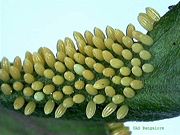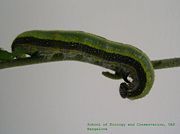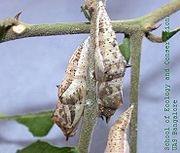
Anaphaeis aurota
Encyclopedia
The Pioneer White or African Caper White (Belenois aurota) is a small to medium-sized butterfly
of the Family Pieridae
, that is, the Yellows and Whites, which is found in South Asia
and Africa
. In Africa, it is also known as the Brown-veined White, and is well-known during summer and autumn when large numbers migrate north-east over the interior.
_i_img_0407.jpg) The upperside of males is white with the forewing having the costa from base to base of vein 11 dusky black and then jet black continuing into a widened and curving short streak along the disco-cellulars to the lower apex of the cell; apical area diagonally with the termen black, the former with six elongate outwardly pointed spots of the ground-colour enclosed one in each of the interspaces 3, 4, 5, 6, 8, and 9. Hind wing: uniform, the black along the venation on the underside seen through by transparency; termen between veins 2 and 6 somewhat broadly black, with a series of four round spots of the ground-colour in the interspaces; below vein 2 and above vein 6 the termen is very narrowly black. Underside: fore wing white, markings similar, more clearly defined, the white spots within the black apical area larger. Hind wing: yellowish white, all the reins very broadly bordered with black; interspaces 1, 2, 6, and 7 with cross-bars of black, beyond which there is a subterminal, somewhat broad, transverse band of black between veins 2 and 6. Cilia of both fore and hind wings white alternated with black. The ground-colour on both upper and under sides variable, often cream-coloured above; beneath: in some specimens, the base of cell and the elongate spots in apical area of fore wing, and the whole surface of the hind wing varies to rich chrome-yellow.
The upperside of males is white with the forewing having the costa from base to base of vein 11 dusky black and then jet black continuing into a widened and curving short streak along the disco-cellulars to the lower apex of the cell; apical area diagonally with the termen black, the former with six elongate outwardly pointed spots of the ground-colour enclosed one in each of the interspaces 3, 4, 5, 6, 8, and 9. Hind wing: uniform, the black along the venation on the underside seen through by transparency; termen between veins 2 and 6 somewhat broadly black, with a series of four round spots of the ground-colour in the interspaces; below vein 2 and above vein 6 the termen is very narrowly black. Underside: fore wing white, markings similar, more clearly defined, the white spots within the black apical area larger. Hind wing: yellowish white, all the reins very broadly bordered with black; interspaces 1, 2, 6, and 7 with cross-bars of black, beyond which there is a subterminal, somewhat broad, transverse band of black between veins 2 and 6. Cilia of both fore and hind wings white alternated with black. The ground-colour on both upper and under sides variable, often cream-coloured above; beneath: in some specimens, the base of cell and the elongate spots in apical area of fore wing, and the whole surface of the hind wing varies to rich chrome-yellow.
Female similar; the black markings on both upper and under sides broader, the white spots on black apical area of fore wing often sub-obsolete above.
Antennae in both sexes black, sparsely sprinkled with white dots; head, thorax and abdomen above and below white: thorax above often bluish grey.

_i_img_6406.jpg) Similar to wet-season form but on the upperside the black markings are narrower, the white markings on the black apical area of fore wing broader and longer, and on the hind wing the narrow inner margining to the black on the termen very narrow, somewhat obsolescent; therefore, the white subterminal spots have the appearance of opening inwards. Underside: ground-colour almost pure white; on the hind wing slightly tinged with yellow. Antennae, head, thorax, and abdomen as in the wet-season form.
Similar to wet-season form but on the upperside the black markings are narrower, the white markings on the black apical area of fore wing broader and longer, and on the hind wing the narrow inner margining to the black on the termen very narrow, somewhat obsolescent; therefore, the white subterminal spots have the appearance of opening inwards. Underside: ground-colour almost pure white; on the hind wing slightly tinged with yellow. Antennae, head, thorax, and abdomen as in the wet-season form.
Wing expanse of 44–62 mm.
Race taprobana, Moore. (Sri Lanka
) Differs from the typical form as follows:
Male upperside, fore wing: deep black on apical area, the enclosed white elongate spots more or less obsolete. Hind wing: the black terminal border much broader and of a deeper black, the enclosed white spots, except the spot in interspace 6, very much smaller, somewhat obsolescent, sometimes absent in interspace 4. Underside: similar to the upperside, the markings of a very intense black and broader, the enclosed spots in the apical area of fore wing, the white of the cell and the area along the upper half of the wing generally overlaid with rich chrome-yellow. Hind wing: ground-colour a deep rich chrome-yellow, the spots on it enclosed in the black along terminal margin subhastate, the spot in interspace 4 absent.
Female Similar to the male on both upper and under sides, but in most specimens, on the upperside, the spots of the white ground-colour that are enclosed in the black apical area of the fore wing and the spots on the black border along the terminal margin of the hind wing are entirely absent.
_mating_w_img_9492.jpg) Sri Lanka
Sri Lanka
, the Himalayas
from Kashmir
to Sikkim
at elevations below 6000 feet, and through the plains to Southern India. In the Nilgiris
observed up to 8000 feet (Hampson
). To the west it spreads through Persia and Arabia to East Africa. The species occurs over the greater part of sub-Saharan Africa
.
 Food plants of the larvae include Capparis zeylanica. In Africa, the host plants are almost exclusively from the family Capparaceae
Food plants of the larvae include Capparis zeylanica. In Africa, the host plants are almost exclusively from the family Capparaceae
and in particular the genera Boscia
, Maerua
and Capparis
. Eggs are laid in batches of 20 or so, while the newly-hatched larvae are gregarious.


Butterfly
A butterfly is a mainly day-flying insect of the order Lepidoptera, which includes the butterflies and moths. Like other holometabolous insects, the butterfly's life cycle consists of four parts: egg, larva, pupa and adult. Most species are diurnal. Butterflies have large, often brightly coloured...
of the Family Pieridae
Pieridae
The Pieridae are a large family of butterflies with about 76 genera containing approximately 1,100 species, mostly from tropical Africa and Asia. Most pierid butterflies are white, yellow or orange in coloration, often with black spots...
, that is, the Yellows and Whites, which is found in South Asia
South Asia
South Asia, also known as Southern Asia, is the southern region of the Asian continent, which comprises the sub-Himalayan countries and, for some authorities , also includes the adjoining countries to the west and the east...
and Africa
Africa
Africa is the world's second largest and second most populous continent, after Asia. At about 30.2 million km² including adjacent islands, it covers 6% of the Earth's total surface area and 20.4% of the total land area...
. In Africa, it is also known as the Brown-veined White, and is well-known during summer and autumn when large numbers migrate north-east over the interior.
Wet season form
_i_img_0407.jpg)
Female similar; the black markings on both upper and under sides broader, the white spots on black apical area of fore wing often sub-obsolete above.
Antennae in both sexes black, sparsely sprinkled with white dots; head, thorax and abdomen above and below white: thorax above often bluish grey.
Dry-season form

_i_img_6406.jpg)
Wing expanse of 44–62 mm.
Race taprobana, Moore. (Sri Lanka
Sri Lanka
Sri Lanka, officially the Democratic Socialist Republic of Sri Lanka is a country off the southern coast of the Indian subcontinent. Known until 1972 as Ceylon , Sri Lanka is an island surrounded by the Indian Ocean, the Gulf of Mannar and the Palk Strait, and lies in the vicinity of India and the...
) Differs from the typical form as follows:
Male upperside, fore wing: deep black on apical area, the enclosed white elongate spots more or less obsolete. Hind wing: the black terminal border much broader and of a deeper black, the enclosed white spots, except the spot in interspace 6, very much smaller, somewhat obsolescent, sometimes absent in interspace 4. Underside: similar to the upperside, the markings of a very intense black and broader, the enclosed spots in the apical area of fore wing, the white of the cell and the area along the upper half of the wing generally overlaid with rich chrome-yellow. Hind wing: ground-colour a deep rich chrome-yellow, the spots on it enclosed in the black along terminal margin subhastate, the spot in interspace 4 absent.
Female Similar to the male on both upper and under sides, but in most specimens, on the upperside, the spots of the white ground-colour that are enclosed in the black apical area of the fore wing and the spots on the black border along the terminal margin of the hind wing are entirely absent.
Distribution
_mating_w_img_9492.jpg)
Sri Lanka
Sri Lanka, officially the Democratic Socialist Republic of Sri Lanka is a country off the southern coast of the Indian subcontinent. Known until 1972 as Ceylon , Sri Lanka is an island surrounded by the Indian Ocean, the Gulf of Mannar and the Palk Strait, and lies in the vicinity of India and the...
, the Himalayas
Himalayas
The Himalaya Range or Himalaya Mountains Sanskrit: Devanagari: हिमालय, literally "abode of snow"), usually called the Himalayas or Himalaya for short, is a mountain range in Asia, separating the Indian subcontinent from the Tibetan Plateau...
from Kashmir
Kashmir
Kashmir is the northwestern region of the Indian subcontinent. Until the mid-19th century, the term Kashmir geographically denoted only the valley between the Great Himalayas and the Pir Panjal mountain range...
to Sikkim
Sikkim
Sikkim is a landlocked Indian state nestled in the Himalayan mountains...
at elevations below 6000 feet, and through the plains to Southern India. In the Nilgiris
Nilgiris (mountains)
The Nilgiri , often referred to as the Nilgiri Hills, are a range of mountains with at least 24 peaks above , in the westernmost part of Tamil Nadu state at the junction of Karnataka and Kerala states in Southern India...
observed up to 8000 feet (Hampson
George Francis Hampson
Sir George Francis Hampson, 10th Baronet was a British entomologist.Hampson studied at Charterhouse School and Exeter College, Oxford. He travelled to India to become a tea-planter in the Nilgiri Hills of the Madras presidency , where he became interested in moths and butterflies...
). To the west it spreads through Persia and Arabia to East Africa. The species occurs over the greater part of sub-Saharan Africa
Sub-Saharan Africa
Sub-Saharan Africa as a geographical term refers to the area of the African continent which lies south of the Sahara. A political definition of Sub-Saharan Africa, instead, covers all African countries which are fully or partially located south of the Sahara...
.
Life cycle

Capparaceae
Capparaceae , commonly known as the Caper family, is a family of plants in order Brassicales. As currently circumscribed, it contains 33 genera and about 700 species...
and in particular the genera Boscia
Boscia
Boscia is a genus of plant in family Capparaceae. It contains the following species:* Boscia albitrunca Gilg & Ben.* Boscia angustifolia A...
, Maerua
Maerua
Maerua is a genus of plant in family Capparaceae. Among its species:* Maerua acuminata Oliver* Maerua andradae Wild* Maerua brunnescens Wild* Maerua crassifolia Forssk.* Maerua elegans R. Wilczek...
and Capparis
Capparis
Capparis is a flowering plant genus in the family Capparaceae which is included in the Brassicaceae in the unrevised APG II system. These plants are shrubs or lianas and are collectively known as caper shrubs or caperbushes...
. Eggs are laid in batches of 20 or so, while the newly-hatched larvae are gregarious.
Larva

Pupa


